Research
 Our goal: Understand and explore electro-thermal transport and thermoelectric energy conversion in materials and devices, particularly on the nanoscale where ballistic and non-equilibrium effects are prevalent. To achieve this goal we utilize and advance theoretical modeling. Our research spans from fundamental to applied: we advance the science to address challenges and enable innovations in thermoelectrics, electronics and heat management.
Our goal: Understand and explore electro-thermal transport and thermoelectric energy conversion in materials and devices, particularly on the nanoscale where ballistic and non-equilibrium effects are prevalent. To achieve this goal we utilize and advance theoretical modeling. Our research spans from fundamental to applied: we advance the science to address challenges and enable innovations in thermoelectrics, electronics and heat management.
Our approach: We utilize, extend and develop first-principles-based modeling methods for accurate, predictive calculations. Specifically, density functional theory (DFT) provides detailed material properties, which are combined with rigorous transport theory (for example, non-equilibrium Green's functions, Boltzmann transport equation, or Landauer approach) to extract the transport characteristics within a parameter-free formalism. We also develop simple, accurate and physically transparent models that capture the essential physics to treat electro-thermal transport on all length and times scales. Such models compliment the rigorous first-principles modeling, span the nano-to-macro hierarchy, and are well-suited for experimental analysis and technology design.
Areas of research:
 First principles predictions of materials properties (bulk or nanostructured)
First principles predictions of materials properties (bulk or nanostructured)
To help gain physical insight, guide experimental efforts and accelerate innovations, we utilize and advance DFT-based transport modeling to predict electron, phonon and thermoelectric transport characteristics. This involves calculating electron and phonon dispersions from DFT, in addition to computing the detailed scattering physics to obtain the transport properties.
We are working at the cutting edge to compute rigorous electron-phonon scattering rates, phonon-phonon scattering rates, and impurity scattering rates (these are the dominant scattering processes for electrons and phonons), all within a first-principles formalism. This information enables us to calculate electro-thermal transport characteristics including electrical conductivity, Seebeck coefficient, electronic and lattice thermal conductivities, as a function of temperature and carrier concentration. Beyond providing accurate predictions of material properties, these detailed results allow us to analyze and understand what fundamental material characteristics are beneficial for given applications, and to design materials with these enhanced properties.
 Thermal transport on the nanoscale and through interfaces
Thermal transport on the nanoscale and through interfaces
In recent years, a number of experiments have observed "non-classical" transport of heat when the characteristic length scale is reduced and approaches the phonon mean-free-path. As opposed to traditional diffusive transport, on the nanoscale fewer scattering events occur resulting in ballistic transport effects, which can be qualitatively different. We explore the physics of heat transport under quasi-ballistic and ballistic transport conditions, in which the phonons can be driven far from equilibrium. The goal is to develop a fundamental understanding of heat transport on the nanoscale, to predict measured thermal characteristics from detailed materials properties (obtained from DFT), and to develop simple yet accurate approaches that apply on all length-/time-scales. These simple models are consistent with traditional diffusion equations that are widely used for experimental analysis and design.
We are also interested is investigating electro-thermal transport through heterojunctions. Both electrons and phonons carry energy as they move, and understanding in detail how the energy is converted and transferred when travelling from one material to another is an important area of research. Providing fundamental insights into how heat transport occurs on the nanoscale and through heterojunctions (for example, metal-semiconductor contacts) is important to address challenges related to power dissipation and heat management in electronics and other emerging technologies.
- Non-linear / non-equilibrium thermoelectric conversion
Traditionally thermoelectric research focuses on the linear transport characteristics, where the applied electric fields and temperature gradients are assumed small. We are exploring how thermoelectric (TE) conversion is modified under non-linear conditions of large electric fields/temperature gradients, which can be achieved in nanoscale materials and devices. Such conditions can drive the system away from near-equilibrium and alter the scattering/energy conversion processes. Specifically, we seek to answer: "How are the TE properties modified under non-linear conditions?" and "Can a non-linear, nanoscale TE outperform a bulk TE?"
